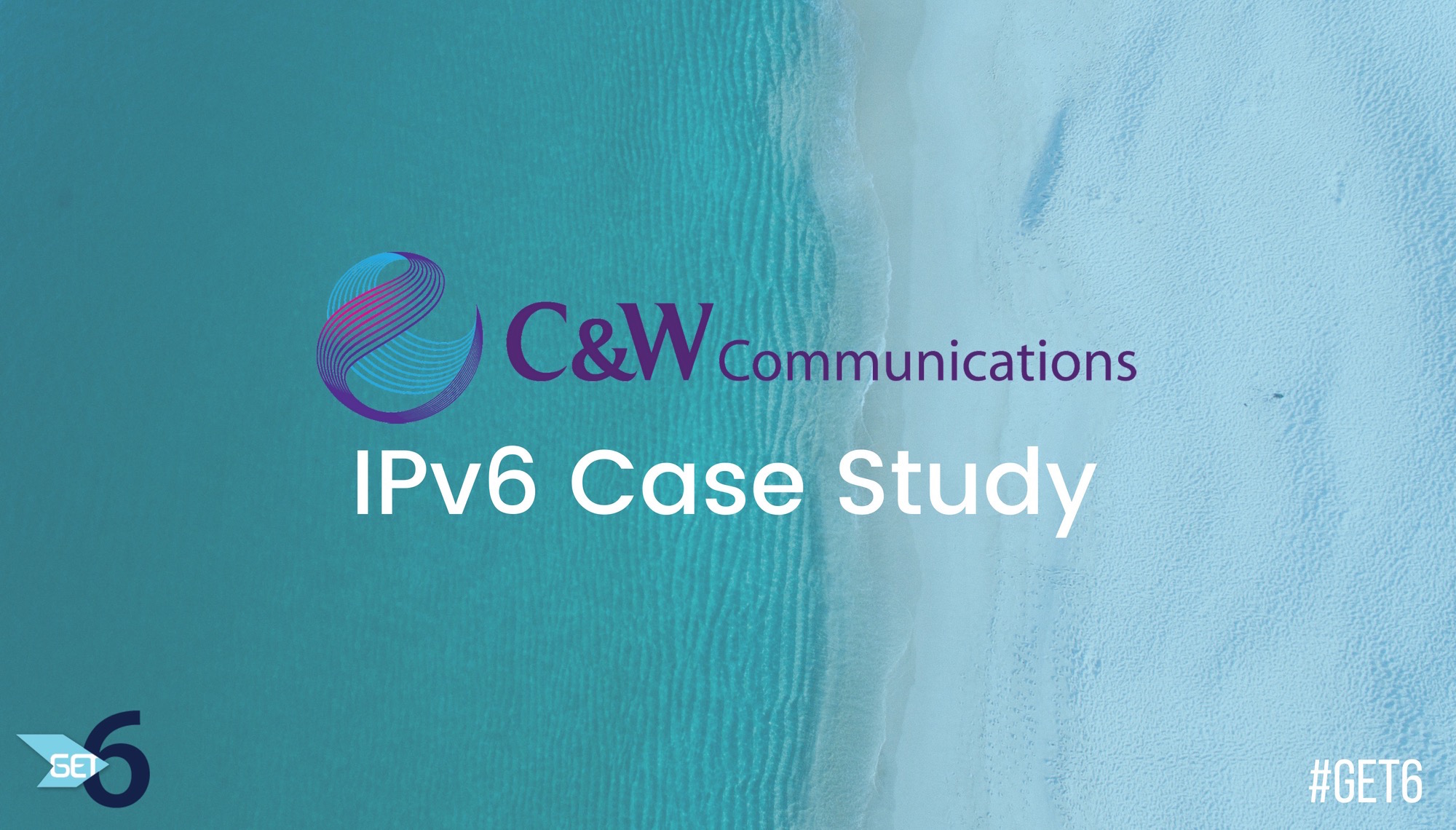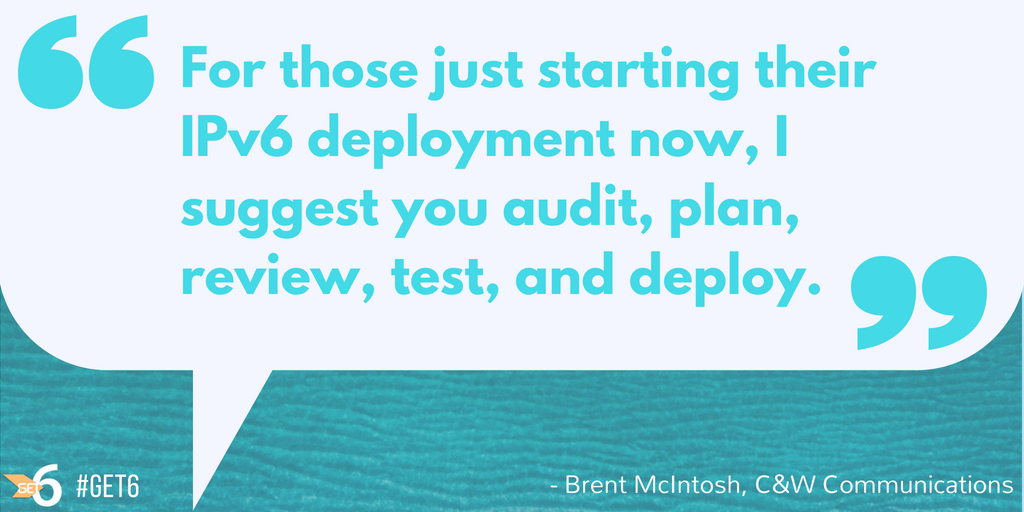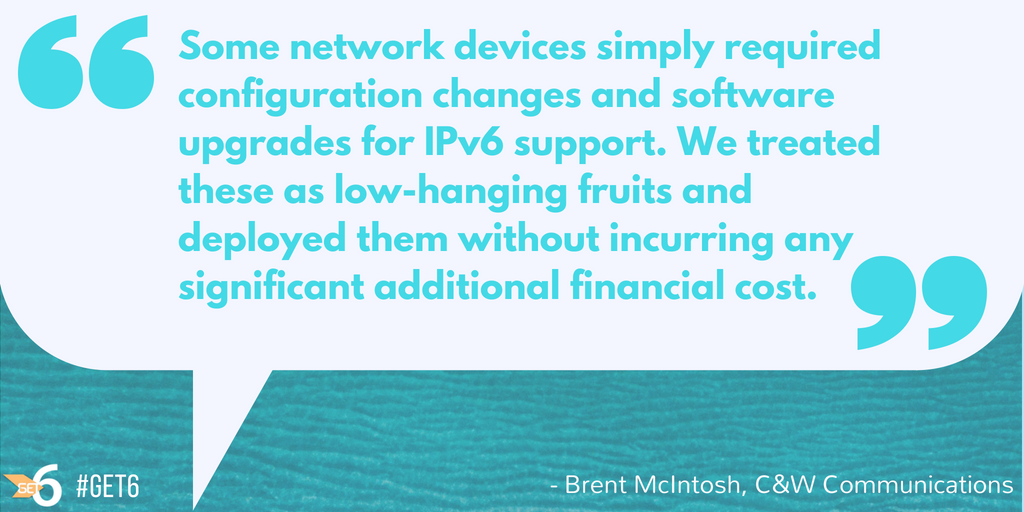
Enabling Internet Access Services over IPv6 in the Caribbean [Archived]
OUT OF DATE?
Here in the Vault, information is published in its final form and then not changed or updated. As a result, some content, specifically links to other pages and other references, may be out-of-date or no longer available.
C&W Communications IPv6 Case Study
C&W Communications, one of the leading telecommunications and entertainment providers in the Caribbean and Latin America, provides Internet access services to business-to-business (B2B) customers and downstream ISPs over IPv6 in several markets. By deploying IPv6, we are able to differentiate ourselves as a leader in Internet services. We currently have over six major B2B customers using our IPv6 connectivity and we stream content from major Content Delivery Networks (CDNs) and hosting providers over IPv6. IPv6 connectivity is critical as many of these CDNs prefer to have dual-stacked networks as a deployment requirement. We currently peer with IXPs in the Caribbean both on IPv4 and IPv6 infrastructure. For example, in Grenada we connect at the Grenada Internet Exchange which is fully IPv6 capable and serves IPv4 and IPv6 content with hosted Akamai caching servers. We do not see IPv6 as optional. We see it as essential!
Even though we were early adopters of IPv6, initially it was a challenge to obtain stakeholder buy in. Today, I believe CTOs and CTIOs have a greater appreciation for IPv6 as a necessary and essential means of ensuring the entire Internet community is being served and that accessibility to content is optimised. Additionally, I believe IPv6 provides the opportunity to facilitate and support the introduction of many other emerging technologies and solutions like IoT and cloud-based anything-as-a-service (XaaS).

5 Step Deployment Plan
For those just starting their IPv6 deployment now, I suggest you audit, plan, review, test, then deploy. Audit your state of readiness for all platforms for IPv6 support, in some cases, with support from vendors. Plan your IPv6 addressing scheme and ensure all stakeholders are updated on plans. Review changes to be made to ensure there will be no major impact to business operations as a result of reconfiguration. Deploy on your production network only after conducting various lab tests. Verify the test results, and only then deploy by configuring IPv6 addresses on the production network.
Initial Motivation
I first became motivated to promote the drive towards IPv6 after attending a LACNIC Regional Internet Registry (RIR) meeting in Trinidad in 2008. At that meeting I had the opportunity to talk with Jordi Palet Martínez, CEO/CTO at The IPv6 Company, whom I had known from my IPv6 research and lab testing days.
Shortly after this, I worked with a team to deploy IPv6 on broadband networks in Trinidad and Grenada by using IPv6-in-IPv4 tunnels. We then applied for IPv6 address allocations from ARIN and LACNIC for our operations in their respective service regions. We went native dual stack, in countries like Trinidad, Grenada, Barbados and Curacao. In order to achieve this, we audited our platforms for IPv6 support and upgraded equipment to make it IPv6-ready. These devices were then reconfigured with IPv6 addressing and IPv6 connectivity to local networks and upstream providers.

Overcoming Obstacles
The main challenge we faced initially was ensuring we had the full engagement and support of the entire organization. This was difficult because we have business operations in 15 Caribbean territories. The formation of an IPv6 Working Group helped overcome this issue.
The initiatives driven by IPv6 Working Group and stakeholder presentations for buy-in for funding included:
-
Audits
-
Training by industry experts
-
Attendance at many IPv6 seminars by various stakeholders including ISOC, ARIN, LACNIC, Packet Clearing House, CaribNOG and the IPv6 Forum
Some network devices simply required configuration changes and software upgrades for IPv6 support. We treated these as low-hanging fruits and deployed them without incurring any significant additional financial cost. After working on the infrastructure which required very little investment, we then planned projects for the major deployments and held technical meetings for project review.
Region-wide Deployment
Today, as clear proof of the success of our strategy, C&W Communications has network core IPv6 dual-stack and BGP peering to transit, B2B and Metro-E Network IPv6 ready in Trinidad, Curacao, Barbados, and Grenada. We have full IPv6 deployment and connectivity to IXPs, and IPv6 transit connectivity for major customers, including downstream ISPs, and IPv6 connectivity to major CDNs like Akamai, Google, Netflix and Facebook in the islands of Trinidad, Curacao, and Grenada.
We also have IPv6 deployment on DOCSIS broadband network completed in Trinidad and Grenada. In other business units and for B2C broadband subscribers IPv6 deployment is still a work in progress.

Building on our IPv6 Success
It feels good to be the first ISP and network engineer of a Caribbean nation to be IPv6 certified by the IPv6 Forum. IPv6 knowledge and experience has helped me to be part of an awesome community where I have had the pleasure to sit on panel discussions at seminars and meet with the industry experts like Chris Grundemann, Carlos Martinez, Arturo Servin, Owen Delong, Shernon Osepa, Jane Coffin, and the list goes on.
The Caribbean region is quickly adopting cloud-based services, and this adoption sees end-users becoming users of these services. A major benefit to ISPs and other enterprises deploying IPv6, is the ease at which IPv6 can make their cloud services readily available at a larger scale. This is just scratching the surface.
The benefits of deploying IPv6 are huge. Caribbean ISPs need to make deployment a top priority. Some parts of the world will be coming online with IPv6 networks only, so we all need to be ready. I for one am prepared to play my part in accelerating Caribbean adoption of IPv6 by sharing my knowledge and experiences. Thankfully, through forums like the Caribbean Network Operators Group (CaribNOG), the Caribbean Peering and Interconnection Forum (CarPIF) and the recently launched ARIN Caribbean Forum, I have the opportunity to do so. Now the lessons learnt in deploying IPv6 across our organization can help clear a path for others to do the same. The resilience of networks across the region depend on it. It should be clear to network engineers and business decision makers that for our networks to scale and thrive in the future, IPv6 deployment is not an option; it is a requirement today.
Any views, positions, statements or opinions of a guest blog post are those of the author alone and do not represent those of ARIN. ARIN does not guarantee the accuracy, completeness or validity of any claims or statements, nor shall ARIN be liable for any representations, omissions or errors contained in a guest blog post.
OUT OF DATE?
Here in the Vault, information is published in its final form and then not changed or updated. As a result, some content, specifically links to other pages and other references, may be out-of-date or no longer available.
